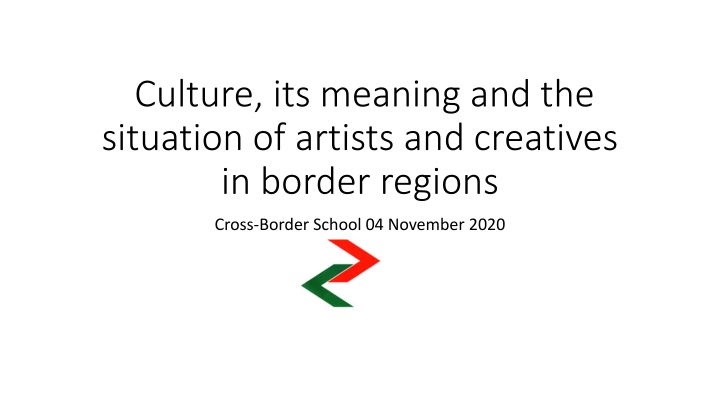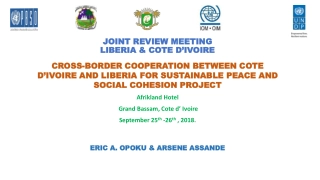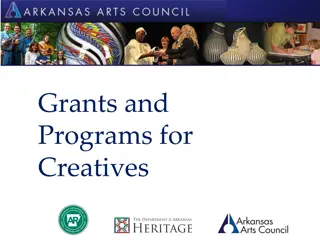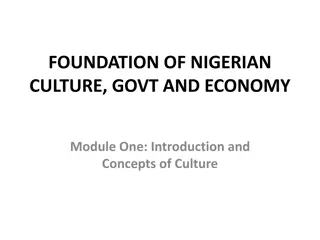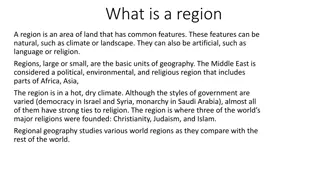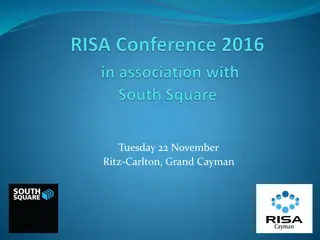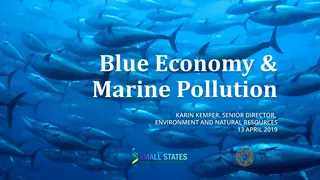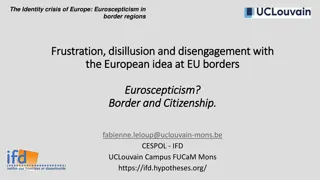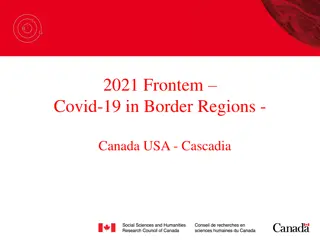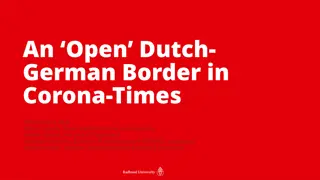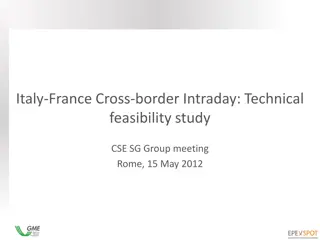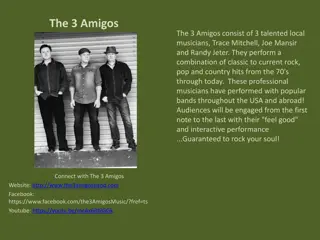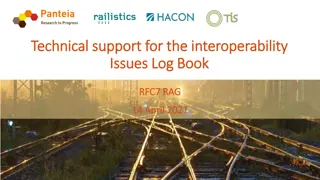The Impact of Artists and Creatives in Border Regions on Culture and Economy
Artists and creatives play a crucial role in the cultural and economic landscape, particularly in border regions where diverse cultures intersect, fostering creativity and innovation. Despite facing challenges, they significantly contribute to social cohesion, the European economy, and the cultural and creative sectors. Recommendations for border regions to support and enhance the potential of artists and creatives are also presented. Cultural employment statistics reveal an underestimation and indicate the substantial impact of the Cultural and Creative Sectors/Industries (CCS/I) on GDP and job creation in the EU. The unique opportunities in border regions for the growth and promotion of culture and creativity are highlighted.
Download Presentation

Please find below an Image/Link to download the presentation.
The content on the website is provided AS IS for your information and personal use only. It may not be sold, licensed, or shared on other websites without obtaining consent from the author.If you encounter any issues during the download, it is possible that the publisher has removed the file from their server.
You are allowed to download the files provided on this website for personal or commercial use, subject to the condition that they are used lawfully. All files are the property of their respective owners.
The content on the website is provided AS IS for your information and personal use only. It may not be sold, licensed, or shared on other websites without obtaining consent from the author.
E N D
Presentation Transcript
Culture, its meaning and the situation of artists and creatives in border regions Cross-Border School 04 November 2020
In my presentation I would like to briefly highlight the following: - the contribution of artists and creative people to the European economy and particularly to the cultural and creative sectors/industries (CCS/I) - the contribution of artists and creative people to culture and social cohesion; - their situation in general and in border regions in particular; Finally, I will present some recommendations addressed to the border regions - on what they can do at the European level - and what they should implement at home.
EU underestimates cultural employment When estimating cultural employment, activities and occupations which areonly partiallycultural wereexcluded fromthe estimation. - Forexample managers of recreation and culturalcentres. - Moreover,theEUcollectsinformationonly oftherespondent s mainjob. Thesecondary jobs are excluded. Inviewoftheselimitations, dataoncultural employment underestimatethetrueextentofemploymentinthisfield. Eurostat Culture statistics 2019 edition, p. 79
In 2015 the CCI/S were estimated to generate about 4.2 % (actually > 5 %) of total EU Gross Domestic Product (GDP) and more than 7 % jobs; The Cultural and Creative Sectors/Industries (CCS/I) are currently above the GDP and employment ratio of the European automobile industry. CCSs are (or have the potential to be) the fastest growing sectors of the economy in Europe; Good Practice Report towards more Efficient Financial Ecosystems: Innovative Instruments to Facilitate Access to Finance for the Cultural and Creative Sectors (CCS), OMC working group of EU member states experts on access to finance for the CCS, November 2015, pp.7 and 15.
The special opportunity of border regions. Where cultures meet, creativity thrives. This applies to large cities but also to border regions Average
All these statistics show us that we are dealing with a rapidly growing economic sector that has overtaken the automotive sector in the last 10 years. Nevertheless, the growth potential remains undervalued and unrecognized. Especially in terms of access to start-up capital and financing * But in contrary to the automotive sector, we are not dealing with a few large corporations employing thousands of people, but with thousands of small and micro enterprises, sometimes employing a few people, sometimes less than one full-time equivalent. *Good Practice Report towards more Efficient Financial Ecosystems: Innovative Instruments to Facilitate Access to Finance for the Cultural and Creative Sectors (CCS), OMC working group of EU member states experts on access to finance for the CCS, November 2015, pp.7 and 15.
About the significance of artists and creatives one can say that without visual artists, musicians, designers, writers, etc. there would be no cultural and creative industries, no public, no private or non-profit culture, no theatres, libraries, museums, ballet, films, etc. * An evidence that we too often tend to forget. * Meeting of the Task Force Cross-Border Culture (T4CBC) in the Greater Region Cultural Area (KRGR), 16 October 2014
As we can see, creatives and artists play a central role. Not only in terms of being the engine of a rapidly growing industry, but also as an indispensable element of cultural added-value that is the cultural creation and to which also belongs, social cohesion and ultimately, the richness of the diversity of humanity is owed. This also is the opinion of the European Commission: Before any economic and social value of the cultural and creative industries, we must take the "cultural added-value" of artists and creatives into consideration. * * European Commission Green Paper on Unlocking the potential of cultural and creative industries, COM (2010) 183 final, p. 5.:
All this is great, but how are the creatives and artists doing? Paradoxically, and despite the economic impact of the CCS/I and the central role for our societies played by creative people and artists, many cultural and creative people live on the edge of poverty *. A little bit black humour to draw attention to the precarious situation of artists: An artist comes to the doctor. Says the doctor: "I have bad news. You only have 14 days to live. And the artist says, "With what?" * See amongst others L artiste au travail, tat des lieux et prospectives, uvre coll., co dition SMart et Bruylant, 2008, Bruxelles ; Loont passie? Een onderzoek naar de sociaal-economische positie van professionele kunstenaars in Vlaanderen, Jessy Siongers, Astrid Van Steen and John Lievens, Onderzoeksgroep CuDOS, Vakgroep Sociologie Universiteit Gent, to be found on http://kunstenpunt.f.mrhenry.be.s3.amazonaws.com/2016/11/rapport-kunstenaars-FINAAL.pdf.
Most artists have to be Patchwork-artists and extremely flexible and mobile They have to accept a variety of working conditions and forms and usually combine several working relationships at the same time. Example of one country, Belgium Percentage of income of visual artists* 26 % Activities as visual artist 18% Activities or commissions as visual artist 3% Income from other creative activities Average = 44 % -> not even half of their activity 30 % Other activities outside of art ( 12% Unemployment benefit 3% Sickness or invalidity pension 1% Career interruption 8% Pension benefits But the situation is really dramatic in the border regions where cultural workers have to cross the border in order to supplement their work income. *Loont passie? Vakgroep Sociologie Universiteit Gent, to be found on http://kunstenpunt.f.mrhenry.be.s3.amazonaws.com/2016/11/rapport-kunstenaars-FINAAL.pdf .
The main difficulties are triggered by the specific work approach and conditions that can be summarized as follows* 1. Work engagements based on different legal statuses: with differences within both the same legal system (active in one member state only) as well as between different legal systems (operating internationally). 2. Project-based work engagements: the professional status of musicians, writers, actors, designers etc. is increasingly characterised by freelance and project-related activities. Most contracts are for short periods of times (from one performance up to several weeks) and for different contractors/employers and less and less by fixed professional positions. *AEBR T4CBC Conference on 27-29 April 2016
3. Double taxation Article 17 of the standard OECD tax treaty Model applied by most Member States in the EU proposes a rule to withhold taxes of foreign artists in the country of actual performance. This means, that cultural actors who is going on tour in several countries are obliged to pay taxes in all countries where they are performing and afterwards must submit requests for tax reimbursement for the tax payed in the countries in which they have performed. The introduction of the rule was based on the assumption that artists (and athletes) are earning a big amount of money and will try to evade taxation by for example, moving to tax paradises such as Monaco or Lichtenstein* * Inspired on the presentation by Dirk Moolenaar from All Arts Tax Rotterdam, the Netherlands, and researcher at the Tax Law department of the Erasmus University Rotterdam hold during the AEBR T4CBC Conference on 27-29 April 2016.
4. Access to correct and up-to-date information at EU level Correct information regarding legal and administrative procedures is difficult to find. Example: how can an artist be identified if the OECD article 17 applies in the different national law systems? Moreover, as the German website Touring Artists* proves, even the most completed and updated information website needs to be complemented with individual accompaniment from professionals in order to make sure that legal and administrative issues are properly addressed. Only a tailor-made validation by experts helps the artists to be in line with legal requirements. * A website supported by the German government where many issues concerning tax, social security, funding, visas, etc. are addressed for both German as foreign cultural actors, see http://www.touring-artists.info/home.html.
5. Social protection models of the member states are non adapted to Cross-Border patchwork-artists Working under several legal statuses has negative impacts on the access to specific social protection mechanisms for patchwork-worker, such as the impossibility to avoid gaps while building up a pension or the right to unemployment benefits. It becomes even more complex when pursued across borders. Definitions and employment statuses vary from a country to another, which may affect taxation and social security rights and other administrative procedures. Furthermore, some countries apply a special regime for artists, such as France and Germany, whether other states do not, like the Netherlands.
Recommendations for border regions: A) Joint lobbying to the EU and member states on the following issues: Removing article 17 of the OECD in their bilateral tax agreements Creation of a network of European, national and cross-border information points including the individual counselling for actors in the CCI/Ss. Recognising by the Member States the specificity of the work situation of CCI/Ss patchwork-workers and artists by adapting their laws to guarantee the same rights and securities as other workers both at national level and cross-border, for example by the possibility of portability of rights.
B) In the border regions: creation of cultural and creative parliaments and a culture and creative one-stop shop with the establishment of a consulting tandem from the cultural and economic sectors to: promote all forms of employment and activity for artists and creatives promote training in CCI/Ss monitor cultural professions develop anchor companies in CCI/Ss provide cross-border legal advice for artistes and creatives support the internationalisation of CCI/Ss assist artistes and creatives in finding studio locations, project partners etc.
Thank you for your attention. I am at your disposal for any questions Rudolf Godesar Chairman AEBR Task Force Cross-Border Culture: www.aebr.eu
